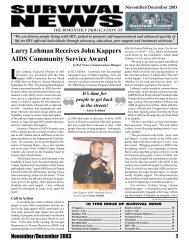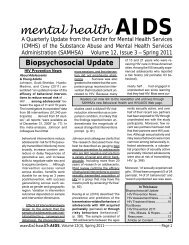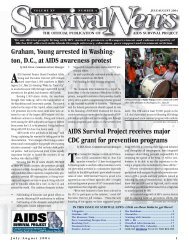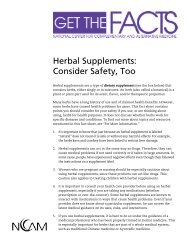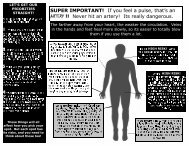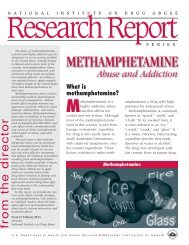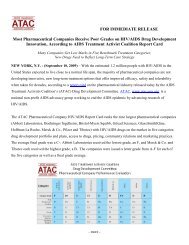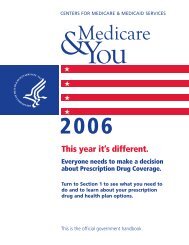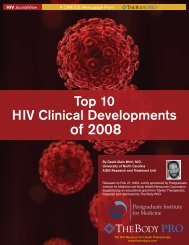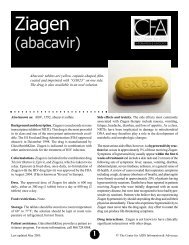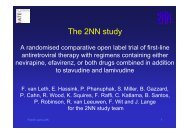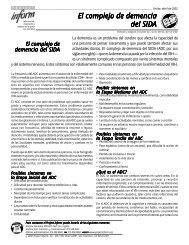Widespread Civil Disobedience Launches South African Campaign
Widespread Civil Disobedience Launches South African Campaign
Widespread Civil Disobedience Launches South African Campaign
You also want an ePaper? Increase the reach of your titles
YUMPU automatically turns print PDFs into web optimized ePapers that Google loves.
Peer<br />
Counseling<br />
Perspecives<br />
Mary Lynn Hemphill,<br />
LMSW<br />
mlhemphill@aidssurvivalproject.org<br />
Making Change<br />
Most of us would like to make some<br />
changes in our lives. New Year’s resolutions<br />
are the most common acknowledgement in<br />
our culture of the acceptability and value of<br />
seeking to improve our behaviors and life<br />
situations through conscious change. Spend<br />
an hour watching television or reading a<br />
popular magazine or newspaper and you<br />
will be inundated with advertisements and<br />
articles that promise you a change in your<br />
life through a particular product or service.<br />
Advertisements for credit cards that buy<br />
you “priceless” happiness, cars that<br />
bestow acceptance into the social<br />
group of your choice and<br />
pharmaceuticals that make you<br />
happier, thinner or more buff, more<br />
active and younger promise<br />
immediate change in your or your<br />
loved ones lives.<br />
While quick, stress-free<br />
change looks appealing and easy<br />
(if you have enough money) the<br />
truth is that change does not come<br />
easily to most people. Often, we<br />
don’t feel like we get to select change –<br />
instead we feel like change happens to us<br />
and then we react to it. As it’s been said,<br />
some people change when they see the light,<br />
others when they feel the heat. Medical<br />
problems often cause us to consider the<br />
need for some change in our lives. The<br />
change may sound simple, such as taking<br />
one antibiotic pill a day for seven days or it<br />
may sound much more complex, like taking<br />
combination antiretroviral therapy plus<br />
interleukin injections with frequent<br />
bloodwork for treatment of HIV and hepatitis<br />
C. Medical consumers, health care<br />
advocates, public health educators and<br />
medical professionals all try to understand<br />
how to facilitate behavior changes that allow<br />
us to be healthier. Whether we like change<br />
or not, it’s built into our lives. What<br />
behavioral science has learned about how<br />
successful changes occur is of value to each<br />
of us.<br />
Basic counseling skills training for peer<br />
counselors at AIDS Survival Project teaches<br />
us that what we are really learning is to<br />
understand what our members want to<br />
change in their lives and how to then be<br />
helpful in the development of a plan to make<br />
that change appropriate, effective and long<br />
lasting – not a simple task! The model we<br />
use is called the Stages of Change Theory.<br />
It was developed specifically in response to<br />
the need to promote lifelong changes in<br />
health-related behaviors. It is useful for a<br />
peer counselor working with someone trying<br />
to adhere to a complicated treatment<br />
regimen, a friend or family member<br />
struggling to deal with an addicted person or<br />
for us to reflect on when we want to make a<br />
change in any aspect of our own life. I invite<br />
you to consider a change you’ve consciously<br />
made in your life or one you would like to<br />
create in the framework of this theory. It<br />
can provide encouragement, a map and grace<br />
if you feel impatient about the speed or<br />
success of the change that you seek.<br />
The Stages of Change Theory as<br />
described by Prochaska, DiClemente and<br />
While quick, stress-free change looks appealing and easy<br />
(if you have enough money) the truth is that change does<br />
not come easily to most people. Often, we don’t feel like<br />
we get to select change – instead we feel like change<br />
happens to us and then we react to it. As it’s been said,<br />
some people change when they see the light, others when<br />
they feel the heat.<br />
Norcross has five stages. The length of the<br />
stages and the process of moving from one<br />
to the other (including sometimes back to an<br />
earlier one!) vary from one person to another.<br />
The first stage is Precontemplation. During<br />
this period a person does not identify<br />
themselves as having a particular problem<br />
(although others around them might), so the<br />
person has no thoughts or intention of<br />
change. In the period of Contemplation a<br />
person realizes that there is something they<br />
want or need to change. Now the person<br />
begins to think about what the problem is<br />
and how they feel about it. Their awareness<br />
is heightened and they are sensitive to<br />
information related to a certain behavior.<br />
From here a person may move to Preparation<br />
for Action, when they come to a decision to<br />
make a change in a relatively short period of<br />
time (around a month) and may begin to<br />
make plans of how they will enact a new<br />
behavior. When someone moves into the<br />
Action stage they are consistently engaging<br />
in the behavior that they want to have become<br />
a new part of their life. The Maintenance<br />
stage is reached when the person is fully<br />
carrying out their new behavior for longer<br />
than six months.<br />
Few changes in our lives go quite as<br />
smoothly as this very, very simplified<br />
description of the theory might seem to<br />
imply. If you’ve ever tried to quit smoking,<br />
for instance, you’ve probably experienced<br />
every one of these stages, plus one called<br />
Recycling, where you’ve returned to an<br />
earlier stage, such as smoking again (but<br />
feeling more guilty!). Many people struggle<br />
with a behavior such as smoking throughout<br />
their lives, moving throughout these stages,<br />
each time a little differently. In terms of<br />
smoking cessation, people often try different<br />
techniques in the Preparation and Action<br />
stages, such as using a nicotine patch,<br />
aversion therapy, positive reinforcement or<br />
limiting the number of cigarettes or the<br />
places where they smoke.<br />
Understanding that behavior changes<br />
occur through stages can be enlightening to<br />
people managing their HIV infection.<br />
As people infected or affected by<br />
HIV we can give each other and<br />
ourselves the support we need to<br />
make constructive, long lasting<br />
changes by providing time, support,<br />
knowledge and encouragement to<br />
develop healthier habits. The<br />
practice of consistent adherence to<br />
medication schedules, safer sex<br />
--Mary Lynn Hemphill techniques, good nutrition, stress<br />
relief, recovery from addictions and<br />
healthy self-care skills do not emerge<br />
fully formed. These practices take time,<br />
patience and resilience because they develop<br />
through change. Next month this column<br />
will share some of the methods that<br />
encourage conscious change. <br />
The Grady Infectious Disease<br />
Program (IDP)<br />
has a new<br />
Client Advisory Committee.<br />
Any IDP client is invited to<br />
participate.<br />
Meetings are held on the first<br />
Thursday of each month at<br />
1:00 p. m. in the P- 40<br />
Conference Room.<br />
The IDP is located at 341<br />
Ponde de Leon Avenue,<br />
Atlanta, GA<br />
For further details call<br />
Carla Johnson at<br />
404-616-9740<br />
4 SURVIVAL NEWS




